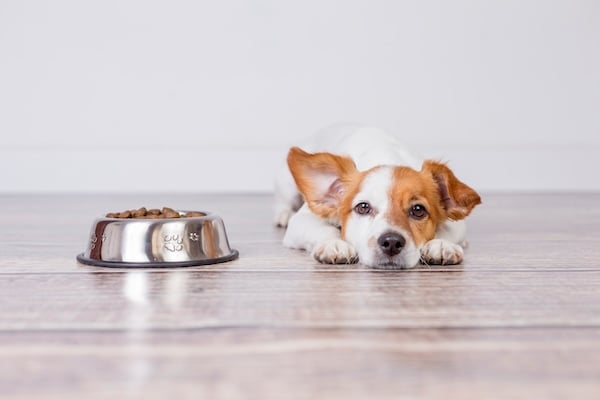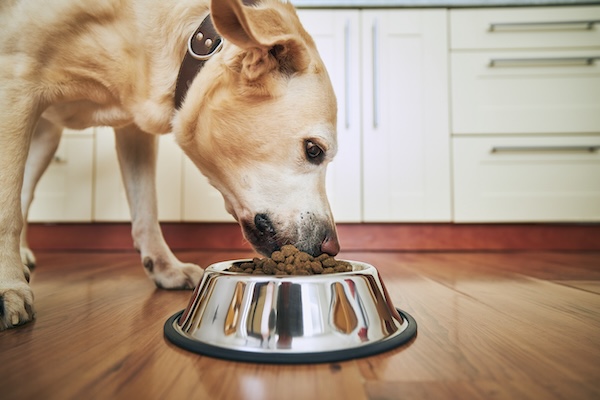What makes one dog drool may hold absolutely no appeal for another pup. Just like people, every dog has their preferences. But if your dog only eats cheap food and turns up their nose at premium-priced alternatives, it’s understandable if you’re a little confused—or even concerned.
What defines ‘cheap’ dog food, anyway? And does it really matter what kind of food your dog prefers as long as it meets their nutritional needs? We spoke to veterinary experts to find the answers.
In this guide, we’ll explore the reasons some dogs display a preference for inexpensive food or ingredients. You’ll also find out what qualifies as quality dog food—independent of price—and learn what to do if your dog’s dietary preferences have become problematic.
Why Do Some Dogs Prefer Cheap Food?
While many dogs are content to eat the same thing every day, that doesn’t mean they don’t enjoy other foods. According to Dr Nell Ostermeier, DVM, CVA, FAAVA, a veterinarian and spokesperson for Figo Pet Insurance, “Some dogs will eat anything, but they usually still have a favourite flavour or food.”
If you’ve got a picky eater on your hands, you can probably make a list of the things your dog will and won’t eat. Other dogs may show subtler signs of preference—scarfing down some foods more quickly than others or begging for treats shortly after mealtime.
When it comes to any individual dog’s preferences, Dr Linda Simon, DVM, a veterinarian at Senior Tail Waggers, says the potential influencing factors are numerous. “There is no doubt that genetics plays a role,” says Dr Simon, “and those who have been bred to be food receptive (like Beagles and Labradors) tend to find nearly everything tasty.”
Familiarity may be a factor as well. Some dogs display a preference for the type of food they ate as puppies, or even the food their mother ate during pregnancy. Preferences can also develop out of habit—some dogs get used to a certain food and struggle to accept anything else.
But how much does food quality factor in? Why do some dogs show a preference for treats over balanced diets or inexpensive food over premium alternatives?
Here’s what makes cheap dog food so appealing
Dr Ostermeier suggests the dog food manufacturing process might have something to do with it. “Kibble is usually sprayed or coated with fats and other ingredients as part of the processing,” she says. Dogs who find this aspect appealing may be particularly drawn to kibble over other types of food.
“Dog food companies spend a lot of time working on the palatability of their diets,” Dr Ostermeier goes on to explain. “They add ingredients that they know will increase desirability for most dogs.” Inexpensive products tend to rely more heavily on additives, so the food might simply be more flavourful and have a stronger or more appealing aroma than other foods.
Plus, the cheapest dog food products are made in bulk batches. Manufacturers have their formulas down to a science to ensure uniformity. Conversely, products made in smaller volumes may exhibit variations in appearance, aroma, or flavour from one batch to another.
You may not notice a difference between batches, but your dog might. And if they’ve developed an affinity for a specific flavour, the difference could be enough to put them off the food entirely.
Now that we’ve explored explanations for why some dogs only eat cheap food, let’s address the big question.

Eva Blanco via iStock
Is It Okay If My Dog Only Wants Budget Foods?
The short answer is yes, it’s okay if your dog only wants to eat cheap food. But there’s a caveat. The food still needs to meet your dog’s nutritional needs—without relying heavily on ingredients or additives that might harm their health.
In other words, healthy budget foods are perfectly fine. Let’s map out what healthy and unhealthy dog food looks like.
Healthy vs. unhealthy budget-friendly dog food
“Each dog has their own needs,” Dr Simon reminds us, “and what is the best diet for one dog won’t be appropriate for another.” Keeping this in mind, here are some qualities of a healthy budget dog food:
- The recipe is formulated to meet minimum canine nutritional requirements. industry regulator UK Pet Food lists 37 essential nutrients.
- It’s nutritionally appropriate for your dog’s life stage (eg puppy food for puppies and adult dog food or all life stages food for mature dogs).
- The food is free from any ingredients your dog is sensitive or allergic to.
- It doesn’t rely heavily on potentially harmful ingredients like artificial colours and synthetic preservatives.
Any product that doesn’t meet your dog’s core nutritional requirements or that contains ingredients that might harm them is not healthy. Here are some indications that a cheap dog food might be unhealthy:
- The formula doesn’t meet UK Pet Food standards or contain or the nutrients needed for your dog’s life stage.
- It relies on artificial additives over natural ingredients for flavour (eg ‘chicken liver flavour’ versus ‘chicken meal’ or ‘natural chicken flavour’).
- The manufacturer has a history of significant product recalls or serious consumer complaints.
- It relies heavily on legumes over more nutritious and easily digestible carbohydrates.
- Your dog experiences digestive upset or other negative health effects after eating the food.
A low price point doesn’t necessarily make a dog food product unhealthy, but it’s worth checking the label to make sure it’s an appropriate choice for your pup. If your dog only wants to eat cheap food and that food isn’t healthy, it’s time to think about making a switch.

Chalabala via iStock
How To Help Your Dog Eat More Nutritiously
Some dogs have no trouble transitioning from one food to another, while others resist dietary change with every fibre of their being. What can you do with a dog who refuses to eat anything other than subpar food or a diet of only treats?
The first step may not be what you expect, but it’s the key to successfully improving your dog’s nutrition. Start by taking a moment to examine your attitude and identify your priorities.
No pet parent wants to take away from their dog’s happiness. But if your dog’s current diet isn’t meeting their needs—or if it’s actively harming their health—you need to take responsibility and remedy the situation. Your dog’s long-term wellness is more important than their immediate satisfaction.
Second, consult your veterinarian to assess your dog’s current state of health. Your vet will be able to tell you if your dog is suffering from nutrient deficiencies and can help identify important features to look for in a new diet.
Here are some actionable steps you can take to help your dog eat more nutritiously.
Steps to improve your dog’s nutrition
- Slowly scale back on the number of treats you offer or switch to a more nutritious product (a healthy single-ingredient meaty treat may tempt even the pickiest pup).
- Implement a consistent daily feeding schedule, if you haven’t already, so your dog gets used to eating at certain times.
- If you’re switching to a different dog food, take the transition slowly—mix the new food with your dog’s current food in gradually increasing amounts over at least seven days.
- Make mealtime fun by using food-dispensing toys or puzzles to boost your dog’s interest in a new food.
- Try adding bone broth or a nutritionally complete meal mixer to the new food to increase its appeal.
- Consider trying a different food type if your dog is resisting the switch (eg changing from kibble to canned food or freeze-dried raw food).
Remember, dietary transitions are supposed to take time. Sudden changes to your dog’s diet can upset their stomach and even increase their resistance to the new food. Be patient with the process and don’t be afraid to turn to your veterinarian for advice.



